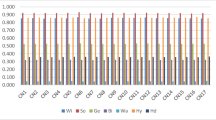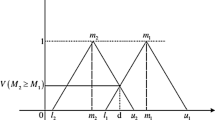Abstract
Renewable energy sources are accepted as an important option as they offer clean and environmentally friendly alternative energy to energy production and fossil fuel consumption. Although renewable energy sources are applicable for every region and country, it is an important issue to produce renewable energy and to decide which energy type should be given priority. Energy priority should be applied according to the most favorable conditions of the country. Considering these important points, in this study, a comprehensive study has been carried out on determining the guiding criteria that should be used for the assignment of renewable energy sources to the right regions. In line with the information obtained from the literature and expert opinions, the criteria to be used in the selection of renewable energy sources have been listed. For 32 sub-criteria under the main dimensions (economic, social, environmental, firm competency and technical), their weights are determined besides examining the effect levels with structural equation modeling (SEM). With the help of these weights, the COPRAS method, which is one of the appropriate multi-criteria decision-making methods, and a final wide-scale criterion table, is conducted across Turkey for renewable energy study. In order to choose the most suitable renewable energy according to this region, solar energy, wind energy, hydroelectric energy, biomass energy and geothermal energy are taken into consideration and the ranking is carried out with the COPRAS method.





Similar content being viewed by others
Data availability
The data that support the findings of this study are available from the corresponding author.
References
Akash BA, Mamlook R, Mohsen MS (1999) Multi-criteria selection of electric power plants using analytical hierarchy process. Electr Power Syst Res 52(1):29–35
Aksu B (2018) Firmaların Eko-İnovasyona Dayalı Sürdürülebilir Performanslarının İncelenmesinde Bir Model Önerisi Ve Analizi, Kocaeli Üniversitesi Fen Bilimleri Enstitüsü Endüstri Mühendisliği Anabilim Dalı, Doktora Tezi
Al GH, Kassem A, Awasthi A, Komljenovic D, Al-Haddad K (2016) A multicriteria decision making approach for evaluating renewable power generation sources in Saudi Arabia. Sustain Energy Technol 16:137–150
Ali T, Nahian AJ, Ma H (2020) A hybrid multi-criteria decision-making approach to solve renewable energy technology selection problem for Rohingya refugees in Bangladesh. J Clean Prod 273:122967
Alizadeh R, Soltanisehat L, Lund PD, Zamanisabzi H (2020) Improving renewable energy policy planning and decision-making through a hybrid MCDM method. Energy Policy 137:111174
Alkan Ö, Albayrak ÖK (2020) Ranking of renewable energy sources for regions in Turkey by fuzzy entropy based fuzzy COPRAS and fuzzy MULTIMOORA. Renew Energy 162:712–726
Alkan Ö, Oktay E, Genç A, Çelik AK (2017) An investigation of exporteimport ratios in Turkey using spline regression models. Ekonom Istraz 30:223–237
Amer M, Daim TU (2011) Selection of renewable energy technologies for a developing county: a case of Pakistan. Energy Sustain Dev 15(4):420–435
Ayçin E (2020) Çok kriterli karar verme: Bilgisayar uygulamalı çözümler. 2. Basım, Nobel Yayıncılık, Ankara.
Barry ML, Steyn H, Brent A (2011) Selection of renewable energy technologies for Africa: eight case studies in Rwanda. Tanzan Malawi Renew Energy 36(11):2845–2852
Basaran ST, Dogru AO, Balcik FB, Ulugtekin NN, Goksel C, Sozen S (2015) Assessment of renewable energy potential and policy in Turkey e toward the acquisition period in European Union. Environ Sci Pol 46(82–94):45
Beccali M, Cellura M, Mistretta M (2003) Decision-making in energy planning application of the electre method at regional level for the diffusion of renewable energy technology. Renew Energy 28(13):2063–2087
Bentler PM (1986) Structural modeling and psychometrica: an historical perspective on growth and achievements
Bento N, Borello M, Gianfrate G (2020) Market-pull policies to promote renewable energy: a quantitative assessment of tendering implementation. J Clean Prod 248:119209
BNEF (2014) file:///C:/Users/Lenovo/Desktop/wwf_turkiye_turkiye_nin_yenilenebilir_gucu_raporu_1.pdf
Büyüközkan G, Güleryüz S (2017) Evaluation of renewable energy resources in turkey using an integrated MCDM approach with linguistic interval fuzzy preference relations. Energy 123:149–163
Cavallaro F, Ciraolo L (2005) A multicriteria approach to evaluate wind energy plants on an Italian island. Energy Policy 33(2):235–244
Deveci K, Cin R, Kağızman A (2020) A modified interval valued intuitionistic fuzzy CODAS method and its application to multi-criteria selection among renewable energy alternatives in Turkey. Appl Soft Comput 96:106660
Elkadeem MR, Younes A, Sharshir SW, Campana PE, Wang S (2021) Sustainable siting and design optimization of hybrid renewable energy system: a geospatial multi-criteria analysis. Appl Energy 295:117071
Enerji ve Tabii Kaynaklar Bakanlığı (2019–2023) Stratejik Planı, https://sp.enerji.gov.tr/ETKB_2019_2023_Stratejik_Plani.pdf
Erdin C, Ozkaya G (2019) Turkey’s 2023 energy strategies and investment opportunities for renewable energy sources: site selection based on ELECTRE. Sustainability 11:2136
ETKB (2017) 2015–2017 Stratejik Planı (Güncellenmis¸ Versiyon, Kasım 2017), Enerji ve Tabii Kaynaklar Bakanlığı, Ankara. 46
Genç M, Akilli M (2019) The correlation between renewable energy knowledge and attitude: a structural equation model with future’s educators. J Balt Sci Educ 18(6):866
Georgopoulou E, Lalas D, Papagiannakis L (1997) A multicriteria decision aid approach for energy planning problems: The case of renewable energy option. Eur J Oper Res 103(1):38–54
Gokmen A, Temiz D (2015) The importance and impact of fossil and renewable € energy sources in Turkey on business and the economy. Energy Sources Part B 10:14–20
Haralambopoulos DA, Polatidis H (2003) Renewable energy projects: structuring a multi-criteria group decision-making framework. Renew Energy 28(6):961–973
Higueras-Castillo E, Liébana-Cabanillas FJ, Muñoz-Leiva F, Molinillo S (2019) The role of collectivism in modeling the adoption of renewable energies: a cross-cultural approach. Int J Environ Sci Technol 16(4):2143–2160
Hox JJ, Bechger TM (2002) An introduction to structural equation modeling. Family Sci Rev 11:354–373
IEA (2013) CO2 Emissions from fuel combustion (2013 edition)
Türkiye Elektrik İletim AŞ (TEİAŞ) (2016) Türkiye Enerji İstatistikleri, http://www.teias.gov.tr/TurkiyeElektrikIstatistikleri.aspx, erişim tarihi: 14 eylül
IPCC (2014) 5. Değerlendirme Raporu 3. Çalışma Grubu Raporu: İklim Değişikliğiyle Mücadele. http://mitigation2014.org/report/summary-for-policy-makers
IRENA (International renewable energy agency) (2015) Renewable power generation costs in 2014, 24
Irfan M, Zhao ZY, Li H, Rehman A (2020a) The influence of consumers’ intention factors on willingness to pay for renewable energy: a structural equation modeling approach. Environ Sci Pollut Res 1–15:47
Irfan M, Zhao ZY, Rehman A, Ozturk I, and Li H (2020a) Consumers' intentionbased influence factors of renewable energy adoption in Pakistan: a structural equation modeling approach. Environmental Science and Pollution Research, pp 1–14
Jabeen G, Yan Q, Ahmad M, Fatima N, Qamar S (2019) Consumers’ intentionbased influence factors of renewable power generation technology utilization: a structural equation modeling approach. J Clean Prod 237:117737
Kabak M, Dağdeviren M (2014) Prioritization of renewable energy sources for Turkey by using a hybrid MCDM methodology. Energy Convers Manage 79:25–33
Kahraman C, Kaya İ, Cebi S (2009) A comparative analysis for multiattribute selection among renewable energy alternatives using fuzzy axiomatic design and fuzzy analytic hierarchy process. Energy 34(10):1603–1616
Kalaycı Ş (2010) Güvenilirlik analizi. içinde, SPSS Uygulamalı Çok Değişkenli İstatistik Teknikleri. Ankara: Asil Yayıncılık.
Karaaslan A, Gezen M (2017) Forecasting of Turkey’s sectoral energy demand by using fuzzy grey regression model. Int J Energy Econ Pol 7:67–77
Karaaslan A, Gezen M (2022) The evaluation of renewable energy resources in Turkey by integer multi-objective selection problem with interval coefficient. Renewable Energy 182:842–854
Karaca C, Ulutas A (2018) Entropi ve Waspas y€ontemleri kullanılarak Türkiye için uygun yenilenebilir enerji kaynağının seçimi, Ege Akademik Bakıs¸ Derg. 18
Kaya T, Kahraman C (2010) Multicriteria renewable energy planning using an integrated fuzzy VIKOR and AHP methodology: the case of Istanbul. Energy 35(6):2517–2527
Kayış A (2006) SPSS Uygulamalı Çok Değişkenli İstatistik Teknikleri. Asil Yayın Dağıtım Ltd., Şti, Ankara
Kim H, Park E, Kwon SJ, Ohm JY, Chang HJ (2014) An integrated adoption model of solar energy technologies in South Korea. Renew Energy 66:523–531
Kline RB (2011) Convergence of structural equation modeling and multilevel modeling
Koroneos C, Xydis G, Polyzakis A (2013) The optimal use of renewable energy sourcesdthe case of Lemnos Island. Int J Green Energy 10(860–875):48
Kumar A, Sah B, Singh AR, Deng Y, He X, Kumar P, Bansal RC (2017) A review of multi criteria decision making (MCDM) towards sustainable renewable energy development. Renew Sustain Energy Rev 69:596–609
Lee HC, Chang CT (2018) Comparative analysis of MCDM methods for ranking renewable energy sources in Taiwan. Renew Sustain Energy Rev 92:883–896
Ligus M, Peternek P (2018) Determination of most suitable low-emission energy technologies development in Poland using integrated fuzzy AHP-TOPSIS method. Energy Procedia 153:101–106
NETL (2013) Electric disturbance events (OE-417) Annual summaries. Department of Energy http://www.oe.netl.doe.gov/OE417_annual_summary.aspx A.
Nigim K, Munier N, Green J (2004) Pre-feasibility MCDM tools to aid communities in prioritizing local viable renewable energy sources. Renew Energy 29(11):1775–1791
Özcan EC, Erol S (2014) A multi-objective mixed integer linear programming model for energy resource allocation problem: the case of Turkey. Gazi Univ J Sci 27(4):1157–1168
Özcan EC, Ünlüsoy S, Eren T (2017) A combined goal programming–AHP approach supported with TOPSIS for maintenance strategy selection in hydroelectric power plants. Renew Sustain Energy Rev 78:1410–1423
Polatidis H, Haralambopoulos DA, Munda G, Vreeker R (2006) Selecting an appropriate multi-criteria decision analysis technique for renewable energy planning. Energy Sources, Part B 1(2):181–193
Rani P, Mishra AR, Pardasani KR, Mardani A, Liao H, Streimikiene D (2019) A novel VIKOR approach based on entropy and divergence measures of Pythagorean fuzzy sets to evaluate renewable energy technologies in India. J Clean Prod 238:117936
Ren J, Sovacool BK (2015) Prioritizing low-carbon energy sources to enhance China’s energy security. Energy Convers Manage 92:129–136
REN21 Renewables (2015) global status report. Paris: REN21 Secretariat; 2015
Şengül Ü, Eren M, Shiraz SE, Gezder V, Şengül AB (2015) Fuzzy TOPSIS method for ranking renewable energy supply systems in Turkey. Renew Energy 75:617–625
Sitorus F, Brito-Parada PR (2022) The selection of renewable energy technologies using a hybrid subjective and objective multiple criteria decision making method. Expert Syst Appl 206:117839
Solangi YA, Tan Q, Mirjat NH, Ali S (2019) Evaluating the strategies for sustainable energy planning in Pakistan: an integrated SWOT-AHP and Fuzzy-TOPSIS approach. J Clean Prod 236:117655
Stanek W, Czarnowska L, Gazda W, Simla T (2018) Thermo-ecological cost of electricity from renewable energy sources, Renew. Energy 115:87–96
Štreimikienė D, Šliogerienė J, Turskis Z (2016) Multi-criteria analysis of electricity generation technologies in Lithuania. Renew Energy 85:148–156
Worldometer (2020) https://www.worldometers.info/energy/ (Erişim tarihi:16.05 2021)
Yilan G, Kadirgan MN, Çiftçioğlu GA (2020) Analysis of electricity generation options for sustainable energy decision making: the case of Turkey. Renew Energy 146:519–529
Yılmaz V, Çelik EH (2009) Lisrel ile Yapısal Eşitlik Modellemesi, Pegem Akademi, Ankara, 2009
Yılmaz O, Hotunluoğlu H (2015) Yenilenebilir Enerjiye Yönelik Teşvikler ve Türkiye. Adnan Menderes Üniversitesi, Sosyal Bilimler Enstitüsü Dergisi 2(2):74–97
Yücenur GN, Çaylak Ş, Gönül G, Postalcıoğlu M (2020) An integrated solution with SWARA&COPRAS methods in renewable energy production: city selection for biogas facility. Renew Energy 145(2587–2597):50
Zheng G, Wang X (2020) The comprehensive evaluation of renewable energy system schemes in tourist resorts based on VIKOR method. Energy 193:116676
Acknowledgements
This research was supported by Tarsus University Scientific Research Projects Coordinatorship (Project No: MF.20.007). I am grateful to Tarsus University BAP unit for their support.
Author information
Authors and Affiliations
Contributions
EY was responsible for conceptualization, methodology, investigation, analysis and writing.
Corresponding author
Ethics declarations
Conflict of interest
The author declares no competing interests.
Ethical approval
Not applicable.
Consent to participate
Not applicable.
Consent for publication
Not applicable.
Additional information
Editorial responsibility: Jun Yang.
Rights and permissions
Springer Nature or its licensor (e.g. a society or other partner) holds exclusive rights to this article under a publishing agreement with the author(s) or other rightsholder(s); author self-archiving of the accepted manuscript version of this article is solely governed by the terms of such publishing agreement and applicable law.
About this article
Cite this article
Yontar, E. Selection of suitable renewable energy sources for Turkey: SEM–COPRAS method integrated solution. Int. J. Environ. Sci. Technol. 20, 6131–6146 (2023). https://doi.org/10.1007/s13762-023-04943-4
Received:
Revised:
Accepted:
Published:
Issue Date:
DOI: https://doi.org/10.1007/s13762-023-04943-4




